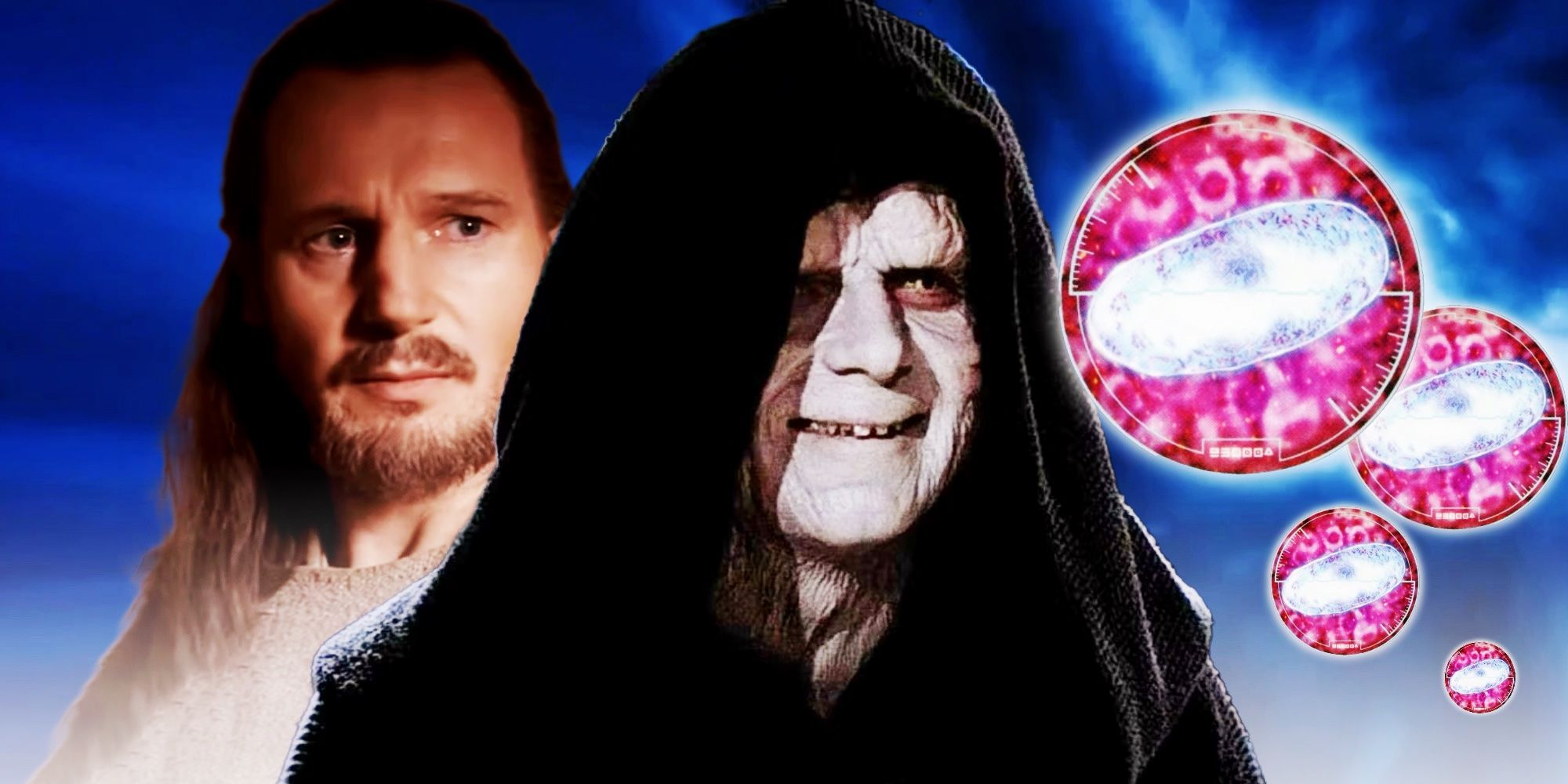Midi-chlorians have been mentioned throughout the Star Wars franchise, raising the question of what they are and how they connect to the Force. Since Star Wars: Episode I – The Phantom Menace was released in 1999, midi-chlorians have retroactively been fit into the franchise’s canon. While they were not conceived of as a concept during the original trilogy, the Star Wars prequel trilogy saw Lucas incorporate the controversial topic of midi-chlorians in The Phantom Menace.
Despite the midi-chlorians causing a stir within the Star Wars fanbase, recent stories have once again made them relevant. Shows like Star Wars: The Bad Batch involved Midi-chlorians heavily within their story, even linking to New Republic stories like The Mandalorian. Another recent Star Wars property that involved midi-chlorians is The Acolyte. With so many references and new details regarding midi-chlorians and, some viewers may require a freshener on what exactly they are within Star Wars canon.
Midi-Chlorians Are The Key To Accessing The Force
Midi-Chlorians Help Force-Sensitives Commune With The Force
In the world of Star Wars, Midi-chlorians are microscopic life forms. The Midi-chlorians exist within the bloodstream of all living beings, with each person having a different number of Midi-chlorians inside them. What makes them so important is their connection to Star Wars’ mystical energy field, as Midi-chlorians help the being they are in symbiosis with commune with the Force. The Midi-chlorians can connect directly with the Force, imbuing their host with the abilities and powers that the Force provides
Initially, Midi-chlorians were so controversial as many mistook them for the Force itself. With Star Wars: Episode I – The Phantom Menace explaining that a high Midi-chlorian count – or M-count – dictates how strong one is with the Force, audiences assumed that Midi-chlorians explained exactly what the Force was. However, this was not Lucas’ intention. Instead, it is simply the case that the more Midi-chlorians a person has, the easier they can access the Force. The Force remains unexplained as the mysterious energy that binds the galaxy together.
In The Acolyte, M-count is mentioned in reference to the characters of Mae and Osha. Mae and Osha are Force-sensitive twins who have mysterious origins, potentially created using the Force. In The Acolyte, the Jedi harbor an interest in the girls for their creations, as well as their strength in the Force. The Acolyte episode 7 has the Jedi conduct tests on the children, revealing that they have an incredibly high concentration of Midi-chlorians. With Osha and Mae being vital to the show, their high M-count may be important to future episodes of The Acolyte.
Everybody Has Their Own Unique Symbionts
Every Person In The Star Wars Galaxy Has An Individual Connection To The Midi-Chlorians
One of the elements of Midi-chlorians in Star Wars is that they require symbiosis. Midi-chlorians are in a mutually beneficial relationship with their hosts; the hosts help Midi-chlorians survive and the Miid-chlorians allow their hosts to commune with the Force. Through this connection, Midi-chlorians and their hosts form a symbiont. These symbionts were mentioned in The Acolyte episode 7, with Torbin explaining that Mae and Osha have identical symbionts. This came as a surprise, as each person is supposed to have a symbiont with the Midi-chlorians that are individual to them.
As has been made clear throughout Star Wars, each person has a different number of Midi-chlorians within their blood. Anakin Skywalker’s Midi-chlorian count, for example, ranks around 20,000. This means that, for every individual cell in his body, Anakin has 20,000 Midi-chlorians, explaining why he is so powerful in the Force. This individual number would give Anakin his own symbiont, which would be very different from the symbiont of someone with 5000 Midi-chlorians per cell, which is the average amount for Force-sensitive beings in the galaxy.
That said, this is not to say that every single person in the Star Wars universe has a different number of Midi-chlorians. Even so, those with the same number of Midi-chlorians in their blood will have a unique symbiont. The reason for this is that Midi-chlorians are living beings, despite being microscopic. As such, how they exist within individual bodies will always be different, explaining the symbiont concept and why The Acolyte‘s reveal centering around Mae and Osha is so important.
Why Midi-Chlorians Are So Difficult To Transfer Through Cloning & Injections
The Cloning Of Midi-Chlorians Has Been Explored In Recent Star Wars Properties
In recent years, Star Wars has involved Midi-chlorians much more heavily in its various projects. As mentioned, Star Wars: The Bad Batch recently explored the concept of Midi-chlorians heavily, as did The Mandalorian. Both these stories, despite being separated by decades within the timeline, explore the cloning of Midi-chlorians tied to Project Necromancer. Project Necromancer is the decades-long plan constructed by Palpatine to survive after death by replicating Midi-chlorians and imparting them in a clone body.

Related
Star Wars’ Project Necromancer & Palpatine’s Resurrection Fully Explained
Star Wars has fully revealed Project Necromancer and the resurrection of Emperor Palpatine thanks to The Bad Batch season 3 and The Mandalorian.
Throughout Star Wars: The Bad Batch, it was explained why it is so difficult for Midi-chlorians to be transferred using cloning. Given that Midi-chlorians are living creatures that live within the body, they have specific living conditions that link to the concept of symbionts. In The Bad Batch, it is explained that Midi-chlorians need to have a viable blood sample to connect with to be transferred between bodies. As the Empire discovered, this proved incredibly difficult. Only Omega, one of the central characters of The Bad Batch, had a blood sample that did not reduce the Midi-chlorian count once combined.
Replicating this connection so that an entirely new body can commune with the Force is incredibly difficult…
While the in-depth science of why this was the case was not outlined, it links to the ethereal concept of the Force. In Star Wars, the Force cannot be explained by science. While Midi-chlorians are inherently scientific, they commune with something entirely inexplicable. The Force cannot be recreated, and Midi-chlorians have a symbiotic relationship with each of their hosts. Replicating this connection so that an entirely new body can commune with the Force is incredibly difficult, as proven by stories like The Bad Batch.
Unlike The Bad Batch, The Acolyte is not expected to delve into the concept of cloning Midi-chlorians. Instead, The Acolyte is more focused on the ethereal, mystical side of the Force. It connects to the creation of life using Midi-chlorians via Osha and Mae, and how dark side powers can allow for this. As such, The Acolyte‘s inclusion of Midi-chlorians is much different from recent stories involving the microscopic lifeforms.
Will Disney’s Star Wars Continue To Explore Midi-Chlorians?
Recent projects send mixed messages
Despite how often midi-chlorians have been referenced in recent projects, it’s hard to know if future Disney Star Wars projects will truly explore midi-chlorians. George Lucas planned on doing so in his treatments for the Star Wars sequel trilogy, but Disney scrapped his ideas in favor of their own approach. Midi-chlorians were a controversial idea among fans, so Disney Star Wars has generally stuck to the mystical side of the Force and only referred to midi-chlorians as “M-count.” However, with the Star Wars prequels being remembered more fondly, perhaps new stories will explore midi-chlorians on a deeper level.

